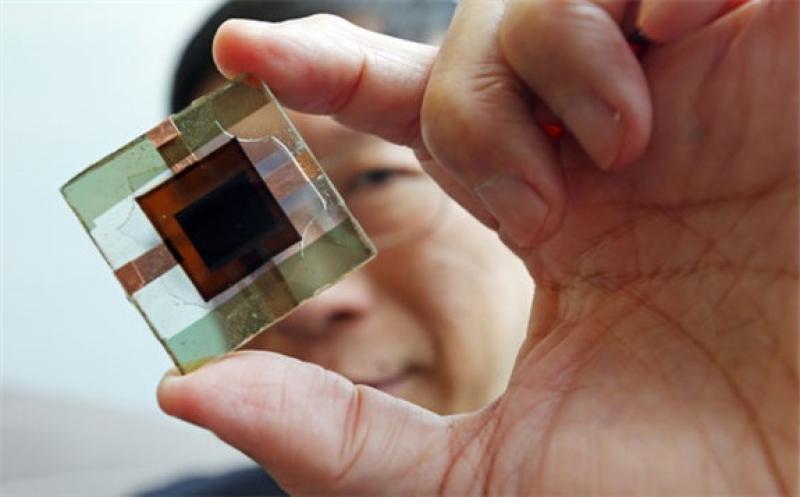
Research teams in Australia and China are inching closer toward a solar cell design that could revolutionize the industry, but plenty of hurdles remain.
The key lies with perovskite, a crystalline structure first discovered in Russia in the mid-1800s. Engineers want to use the material to build cheaper and more efficient solar panels—potentially in tandem with silicon-based panels, which are popular and more durable.
“There’s a lot of emphasis now on improving efficiency, and that’s why there’s suddenly these tandem approaches,” said Thomas White, a research scientist and professor at the Australian National University (ANU).
Another reason, he said: “It’s getting harder and harder to squeeze the manufacturing costs down.”
White and others say the key to advancements lies with improving energy conversion efficiency—the degree to which a panel converts energy from sunlight directly into electricity.
Silicon-based photovoltaic (PV) panels typically see efficiency rates of 16% to 18%, and the theoretical limit for silicon PV efficiency is 29%, researchers say.
Studies suggest a perovskite solar panel could achieve efficiencies as high as 35%, while also reducing costs through cutting out some steps in the manufacturing process.
“The beauty of them is you can process them from solution,” White said in an interview. “Unlike silicon, where you have to go through this very industrialized refinement to get very high purity silicon, these materials we buy effectively as a powder, we mix them into a solvent, and then we can spin coat them or coat them in very thin layers onto a glass substrate, and that potentially makes them very cheap if you can scale it up.”
The potential has attracted attention—and support.
The Australian Renewable Energy Agency (ARENA) recently announced funding in support of research and development toward advanced solar photovoltaic energy applications. An additional $15 million is available for R&D teams to end-of-life solar PV solutions and in particular “increasing the cost-effectiveness of silicon-based solar PV through the use of tandem materials.”
ARENA has elicited support from scientists at the Australian National University and Chinese solar panel manufacturing giant JinkoSolar in the broader R&D effort aimed at commercializing perovskite solar technology.
There have been some early signs of promise.
Last year the ANU team announced a record for a larger perovskite solar cell, achieving 21.6% efficiency in the lab. Researchers in the United States and South Korea have achieved perovskite conversion efficiencies of 24.2%, but ANU said its team’s milestone marked “the highest ever achieved for perovskite cells above a certain size.”
In a recent report on the future of solar PV, the International Renewable Energy Agency (IRENA) described perovskite as “one of the most promising materials” in solar technology research today—“a type of mineral very good at absorbing light” and “very easy to make in the lab.”
It’s worth watching perovskite solar R&D, IRENA said, but the agency cautioned it would take a while before Chinese, Australian, U.S. and other research initiatives crack the code for bringing it to commercial reality.
The largest obstacle remains durability—perovskite crystals break down faster than silicon.
“Because the crystals dissolve easily, they are not able to handle humid conditions and need to be protected by moisture through encapsulation, for instance through an aluminum oxide layer or sealed glass plates,” IRENA explained.
White at ANU acknowledged this deficiency. Perovskite also can’t take heat as well as silicon can, he added.
“The main challenge at the moment is stability,” he said. “We’re still struggling to make them sufficiently stable that you would want to put them on a rooftop for 25 years. So that’s still an unsolved question.”
It’s a challenge he thinks can be overcome, in particular via the “tandem” approach promoted by ARENA, whereby the perovskite is combined with a silicon layer to both greatly enhance sunlight energy conversion and improve durability and stability. The main benefit to the tandem approach is better energy capture.
“If you take two solar cell materials and put them together, you can optimize one cell to absorb blue and green light, which provides high energy, and another cell is optimized for infrared light,” White added. “And if you put the two together, stack one on top of another, then that efficiency limit goes up significantly.”
Abu Dhabi, United Arab Emirates-based IRENA thinks the technology has the potential to transform the solar PV industry “if these barriers can be overcome.”
“Perovskite cells have the potential to change the dynamics and economics of solar power because they are cheaper to produce than solar cells and can be produced at relatively low temperatures, unlike silicon,” the agency concluded.
Engineers based at universities in China and the United States took an in-depth look at the state of perovskite solar cell research in a recent edition of the scientific journal Advanced Functional Materials. Their paper acknowledged the problems with improving stability but also highlighted the “astounding progress in the efficiency of perovskite solar cells.”
Still, the team concluded that the next step must focus on making perovskite as durable as silicon before commercialization can become reality.
White agreed. “That will make or break perovskite over the next few years,” he said.